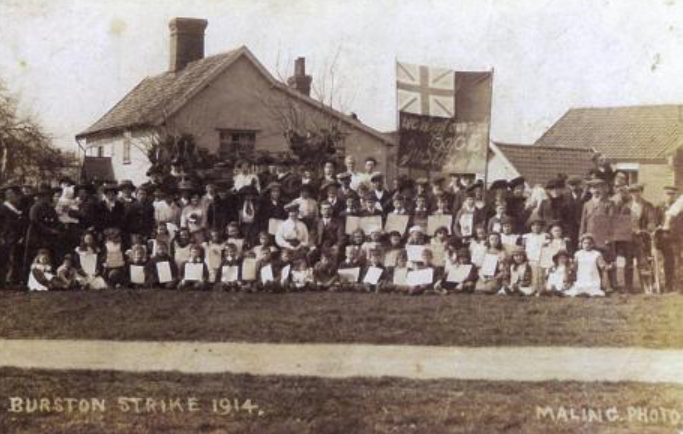By Abigail Pollock, NEU member
Burston, near Diss in Norfolk, is the quintessential English village built around a Green, a Church and an old schoolhouse. In recent years, a slow trickle of visitors has become a steady stream as more and more lefties take a daytrip to the School Strike Museum.
The museum is an unimposing slate roofed hall with the opposing dual entrances, one for girls and Infants and one for boys, that signify a Victorian school. Yet its very ordinariness belies a dramatic past. From 1913 to 1939, the school was the location for one of the hardest fought battles for worker’s rights and education in England. Huge demonstrations in defence of striking teachers and pupils were attended by everyone from Thomas Mann to Sylvia Pankhurst. Even Lenin is said to have sent regular telegrams and parcels in support. Now every year, on the first Sunday after the school holidays, Unite the union holds the Burston School Strike Festival and the village’s place in history is remembered once more.
School attendance mandatory
So, what was the impetus behind this most peaceful of villages become the scene of an educational revolution? In 1902, Balfour’s Conservative government passed the Education Bill, replacing the Elementary Education Act of 1870, a landmark piece of legislation which made school attendance from ages 5 to 12 mandatory. Yet in rural communities like Norfolk, where 90% of the rural poor were farm labourers, elementary schools were strongly resisted by the parish councils.
However, from 1902, responsibility for educating poor children passed to 328 new Local Education Authorities and teachers in state-funded schools became council employees with standardised terms and conditions. The drive for comprehensive elementary education was linked to the efficiency campaign started by Joseph Chamberlain after the Boer War, when he realized that the English working class were so malnourished and ill-educated that the British Army could not effectively defend its own Empire because of to the physical degeneracy of its recruits from the own working class.
Into this big educational push came a generation of working-class schoolmasters and mistresses. For the first time, working class intellects like DH Lawrence could train to be certified schoolteachers. This was a way of achieving a higher education, something that had previously been out of bounds to miners’ sons. Thomas and Annie Higdon were just such a married couple who took their first job with Norfolk Education Board around 1908 at Wood Dalling in Upper Norfolk.
In 1913, Annie Higdon, who taught and ran the school as headmistress, with her husband as assistant, was put on a disciplinary. The Board of Education felt that her methods were unorthodox and contrary to their stipulations, older children were being taught shorthand and typing, photography, astronomy and even French conversation. Even worse, was the accusation of lighting too many fires to dry the children’s clothes and exhausting the school’s coal budget.
The charges were vague and contradictory and the County Council, fearful of the National Union of Teachers and Tom’s status in the National Union of Agricultural and Allied Workers, wanted to avoid a scandal. Rather than sacking the couple, they were offered a transfer to Burston, a larger village, in the hope that a fuss could be avoided. Unfortunately, for the political elite that controlled the rural council, this socialist couple were about to ignite a national educational scandal.
Wood Dalling to Burston
On arriving at Burston School in 1913, the couple set about shaking up the curriculum to make it progressive and aspirational. Instead of interminable Anglican RE, they taught a mix of academic and practical subjects; above all, they resisted the idea that girls would be servants and boys farm labourers and bright children were schooled for the 11-plus.
Burston had a powerful local councillor: the Reverend Elland, who hitherto had controlled the curriculum and the standards. Many of the labouring families worked land belonging to his Church. Locals described the village as almost ‘feudal’ in its social hierarchy, with the Church in cahoots with two or three landowners.
Most families were tenants, so wages were kept artificially low. It was not uncommon for families of eleven to live in a one- or two-room cottage, along with their animals. With male earners on 12 shillings (60p in today’s terms) a week, the only way families could survive was by pulling their children out of school to work on the harvest. Tom Higdon, as an ex-agriculture worker and lay-preacher, offended the Reverend Elland, when he organised labouring men to stand in the parish elections of 1912 and the parish fell to the ILP.
Wasting school funds
By March 1913, the Reverend and the old guard hatched a plot to remove the Higdons. Two Barnardo’s girls, fostered through the Church, accused Mrs Higdon of beating them and again she was charged with wasting school funds on heating and food and straying from the approved curriculum. On the March 311914, the School Board finally dismissed the couple, who informed the 72 pupils that they had been sacked. One older child, Violet Potter, immediately rallied the children, and when a new appointee arrived, she was greeted by a massive demonstration organised by Violet. This was the beginning of a 25-year refusal by the vast majority of working families to send their children back to the official school until the couple were reinstated.
The Higdons never were reinstated. Instead, they erected a marquee and after the daily picket they taught lessons in a tent on the green. Eventually, a local carpenter gave them his building, but this lasted barely a year, as up and down England, trade unions and socialist clubs began to raise funds to build the Burston Strike School. The day it officially opened was May Day 1915, and the labour movement descended on the inauguration of this cause celebre. It continued, offering a free, progressive, comprehensive education to the rural poor, right up until Tom’s death in 1939. The dispute, therefore, spanned the whole of the inter-war period.
Comprehensive education pioneers
Fast forward a hundred years to today and the attacks on left-wing teachers have started again, escalating during the Covid-19 pandemic. As schools try to protect working class children from the pandemic, Rod Liddle wrote a piece in the Sun, stating, “Covid-19 has made heroes of our frontline workers ……but not teachers”. The fear of the socialist teacher was also demonstrated in the sacking of UCU rep and college lecturer David Muritu for opposing the Prevent programme, which has been used to stop political education in the classroom.
Now more than ever teachers and schools are battlegrounds. However, to all who seek to educate, it is worth remembering that the Higdons story was not just an industrial dispute. It was about education for all, a life beyond the cowshed or the dark satanic mills. With their whole-school rambles and socialist hymns, they built a little bit of Jerusalem for their raggedy pupils in England’s green and pleasant land.



